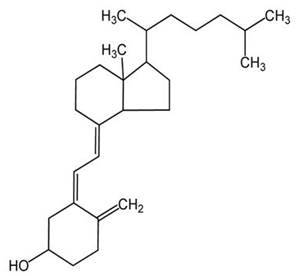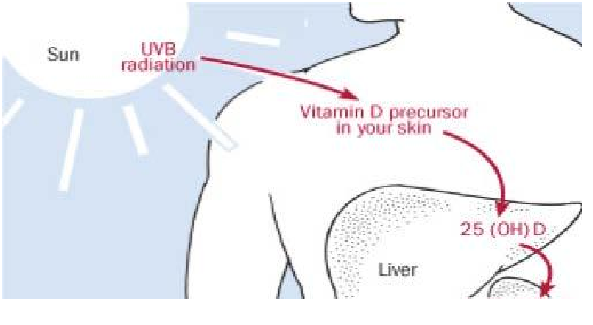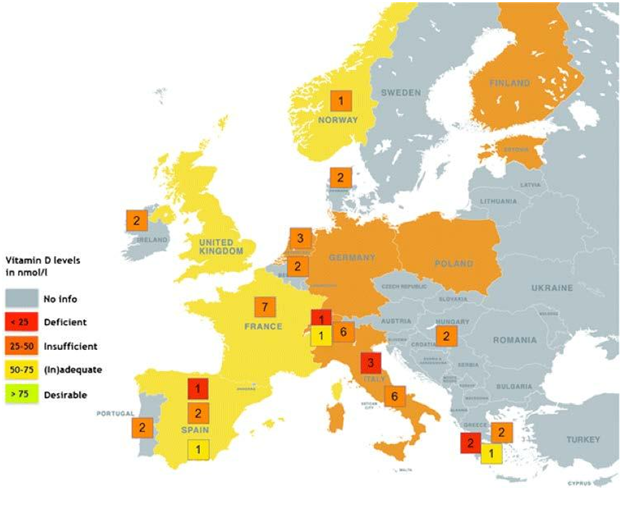MOJ
eISSN: 2381-182X


Mini Review Volume 2 Issue 1
Marine Harvest Group, UK
Correspondence: Kostas Alexiou, Quality Assurer at Marine Harvest Group, UK
Received: July 05, 2015 | Published: January 19, 2016
Citation: Alexiou K. The dietary importance of vitamin D in lifespan of adulthood. MOJ Food Process Technol. 2016;2(1):8-11. DOI: 10.15406/mojfpt.2016.02.00025
The human body is an amazing machine which is responsible for making millions processes simultaneously. The ability of this operation is due to a variety of nutrients which are constituted by carbohydrates, proteins, fats, vitamins and minerals. Each nutrient contributes separately to the proper function of human organism.1
It is noteworthy to say that vitamins play an important role to the operation of human body, as well. The most plentiful chemical components for the nutrition and generally for the body are the vitamins. Vitamins act as catalysts and combining with proteins, they create metabolic active enzymes which are responsible for numerous significant interactions in the body. More specific one of the most useful vitamins is the vitamin D. In 1920, doctors after a long research trying to find ways to treat rickets discovered the vitamin D. Results show that the role of vitamin D is very important for the human body and its bone structure. Additionally, this particular vitamin gives us the suitable energy, making stronger our organism and protecting it at the same time from many diseases. Such diseases are diabetes, neuromuscular and cardiovascular problems. Furthermore, many studies show that vitamin D plays an important role against the prostate cancer. In other words we could say that Vitamin D maintains and improve the immune system of a human body.2
Vitamin D is a fat soluble vitamin which encourages the metabolism and the absorption of phosphorus and calcium inside the human body. There are five different types of vitamin D which have been discovered. These particular types are: vitamin D1, D2, D3, D4 and D5.3
The most important compounds of the above mentioned for the human organism are vitamin D3 cholecalciferol and vitamin D2 ergocalciferol. Both of them are usually ingested through nutrition, supplements and sun.4 Ergocalciferol is mainly human-made. It is also added to foodstuffs and we can find it in fortified foods or in dietary supplements. The main deference between Ergocalciferol and Cholecalciferol is in their side chain structure.5
On the other hand, Cholecalciferol is made by the body and more specific in the skin when the sunlight exposure is adequate. For this reason its common name is “sunshine vitamin”. The amount of vitamin D3 depends on the duration of exposure in the sunlight, the surface of the skin and the wavelength of radiation (Figure 1).6,7

Figure 1 Cholecalciferol.6
There are many sources from where we can absorb the vitamin D. It is commonly known that the sun is the main natural source of vitamin D. The majority of people obtain some of their vitamin D through the sunlight. The sunlight is consisted of ultraviolet (UV) radiation. This radiation has a wavelength of 290-320 nanometres.8 Researchers have shown that the skin pigmentation depends, in a large scale, on the melanin of skin. Many case studies have shown that the human melanin is responsible for the production of vitamin D3 after the UV radiation. The first stage of vitamin’s D metabolism happens in the liver.7
Initially, the UV radiation converts the cutaneous 7-dehydrocholesterol to previtamin D3 with the help of extra hydrogen and oxygen. After this procedure the UV radiation is transformed in vitamin D. All this procedure occurs in the liver and the final stage occurs in the kidney9(Figure 2).

Figure 2 Absorption and Metabolism of Vitamin D.2
There are many factors that influence the synthesis of vitamin D and the UV radiation exposure. The length of the day, the season and the skin melanin content are some of these factors. During the summer, our skin accepts enough percentages of UV, and our organism has the ability to store it in the fat and liver. The absorption from the sunlight is higher at the end of summer end lower at the end of winter. Despite the fact that the sunlight may be bright in winter the UV radiation is very limited.10
On the other hand, we must be cautious with exposure of skin to sunlight. There are many deaths and skin cancer cases have significantly been increased due to the fact that UV radiation is carcinogen. Moreover the American Academy of Dermatology advises that measures must be taken for the protection of skin before exposure the body to the sun, such as high index sunscreen.11
Another source of vitamin D is the food. We can also find vitamin D in a specific number of foods. A rich source of vitamin D is the oily fishes such as mackerel, salmon and tuna and especially their liver oils. Furthermore small amounts of vitamin D are contained in cheese, egg yolk, fortified fat spreads and fortified breakfast cereals. In Canada and United States the liquid milk is voluntarily enriched with 385 UI/l of vitamin D. Moreover fortified plant products should have the same amounts in vitamin D like the liquid milk. The presence of vitamin D in these foods is found mainly in the form of vitamin D3.12
An equally significant fact is that, although the meat has very low quantity of vitamin D, it is still an important source. Its present is mostly the last active metabolite, calcitriol, which is in many times more important on a molar base than is cholecalciferol.10
The deficiency of vitamin D is a result of two important reasons. The first one is the nutrient deficiency which is due to the fact that the dietary is not adequate for our organism. This usually happening when its consumption is lower than recommended levels. Moreover is a common phenomenon that it is noted in diets which are connected with allergy milk, vegetarian’s diets and diets intolerant in lactose. The absorption of dietary calcium in small intestine is no more than 10-15%, without vitamin D.13
It is recognized that the vitamin D and the calcium are interdependent. For this reason the role of vitamin D is very important and sometimes it contributes to the appearance of osteoporosis. Osteoporosis is usually associated with insufficient intake of calcium. Inadequate vitamin D leads to osteoporosis as the absorption of calcium is reduced.14 According to National Institutes of Health Osteoporosis in the United States approximately 40 million adults have or are at danger of developing osteoporosis (National Health of Osteoporosis, 2010).
One more equally important factor of deficiency of vitamin D is the fact that sunlight exposure is very restricted to some countries. Due to this reduction the kidney cannot convert the cutaneous 7-dehydrocholesterol to vitamin D. This is very common in polluted engineering cities and in northerly climates where people are unable to absorb suitable amounts of UV light.15
The lack of this vitamin, during the development of the body causes bone deforming. This deforming is known as rickets. Rickets is one of the most common diseases which presents in children. In adulthood we encounter another disease which is called osteomalacia having as result weak bone structure. Some of the symptoms of this disease are weakness muscle and pain of bones. Especially women who have very low sunlight exposure have the risk of osteomalacia after the period of pregnancy due to the fact that their organism needs more amount of calcium.16
Most European countries have set their own recommendations for the quantities of each nutrient that will be absorbed by the population on daily bases in order to prevent the occurrence of failures and promote good health. The values that are published are also known by terms such as recommended daily intake – RDA. The RDA often varies considerably between countries.8
Approximately 90 % of vitamin D comes from sunlight exposure and so the skin has the ability to use it for its benefit. Many studies report that any exposure of (~20%) the body either direct or indirect, is useful in rising blood concentrations of 25-hydroxyvitamin D3 [25(OH)D3] and vitamin D. The value of vitamin D is measured in international units of biological action, 1μg of vitamin D3 = 40 IU. So the recommended sufficient intake for women and men in adulthood is 600 IU.13
Moreover it is notable the fact that, according to a survey in nursing homes in Great Britain, the use of UVB lights is effective to maintain the appropriate amounts of 25(OH)D in blood.17 Supplements and Excess intake of vitamin D. In recent years, the consumption of nutrition supplements of vitamin D has become more common. The type of vitamin D which is used in supplements foodstuff can be either vitamin D3 or vitamin D2. In the market of supplements, many of these products contained 400 UI per daily dosage but now the levels have increased.12
In general we must be cautious about the intake of vitamins. In this case, the excess of vitamin D can guide us to a situation of hypervitaminosis or intoxication. The first evidences about vitamin’s D intoxication are dated from 1928 to 1932. Hypervitaminosis has as result to lead us in hypercalcimia and finally to soften the tissue calcification creating cardiovascular and renal damage.18 Furthermore the type of vitamin D that is responsible for the intoxication is 25OHD.19
The Europe and especially the Mediterranean countries, regarding their warm climate, have plenty of sunlight exposure, in comparison with Northern countries. The period of summer gives the ability to the people to absorb suitable amounts of vitamin D. Despite the fact that the sun is adequate in these countries, the insufficiency of vitamin D is a common global health issue.4
In 2012, began a survey by DSM in cooperation with IOF which depict the levels of 25(OH)D in Europe. As we can see in the map bellow, the levels of 25(OH)D with yellow colour, for the general population are between 50 and 75 nmol/l. These countries are France, United Kingdom, Corsica, Spain and Norway. On the other hand there are many countries like Switzerland, Germany, Estonia and Finland where the levels of 25(OH)D is insufficient4(Figure 3).

Figure 3 Global Ranking of Vitamin D.4
Summarising the above mentioned, vitamin D differs from other vitamins because our own body can produce it with the help of sunlight. The main characteristic of vitamin D is to control the consumption of calcium and phosphorus in our bones and allow cells communication throughout the body. Even though there are five different types of vitamin D, only two seem to have a great impact to human body. These two are: vitamin D2 and Vitamin D3.
The main source of vitamin D is considered to be the sunlight. Frequent exposure of human body to sunlight has as a result to produce the needed amount of vitamin D for the human organism. However where sunlight exposure is not available due to different climate conditions the dietary supplements are very important.
Some of the advantages of vitamin D are that benefit the immune system, reduces the risk of several types of cancer as well as the hurt attack risks. Moreover it promotes a healthy formation growth. Therefore the deficiency of vitamin D can cause serious health problems.
Estimating the above said, it is essential for people to realize the importance of this vitamin for their healthy growth. Consequently people should discover alternative sources in order to fulfil their daily intake of vitamin D.
In my opinion people should take advantages of good environmental conditions and whenever is possible for them to expose themselves to the sunlight. At the same time they should give more emphasis in their daily nutrition. For example, in our days people prefer to take their proteins through the meat. I would say that a better source of protein is the fishes. People not only fulfil their suitable protein requirement, but they also enrich their organism with vitamin D.
Additionally the vitamin D deficiency, in a larger scale, can be a public health problem. For these reason Governments need to give attention to matters like these and provide solutions for their citizens. A campaign which will promote the awareness of the people regarding the importance of vitamin D would be a good starting point.
None.
The author declares no conflict of interest.

©2016 Alexiou. This is an open access article distributed under the terms of the, which permits unrestricted use, distribution, and build upon your work non-commercially.